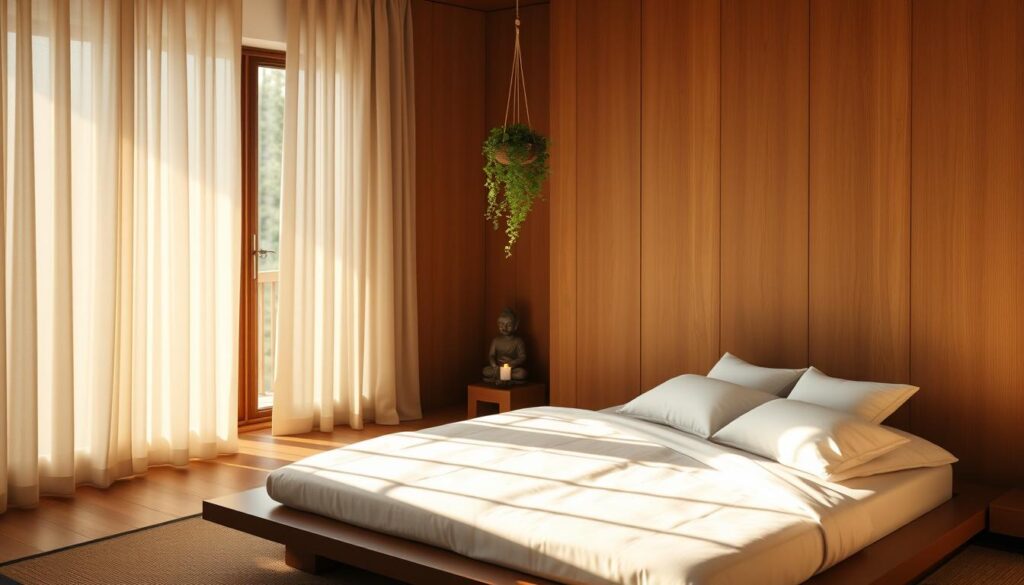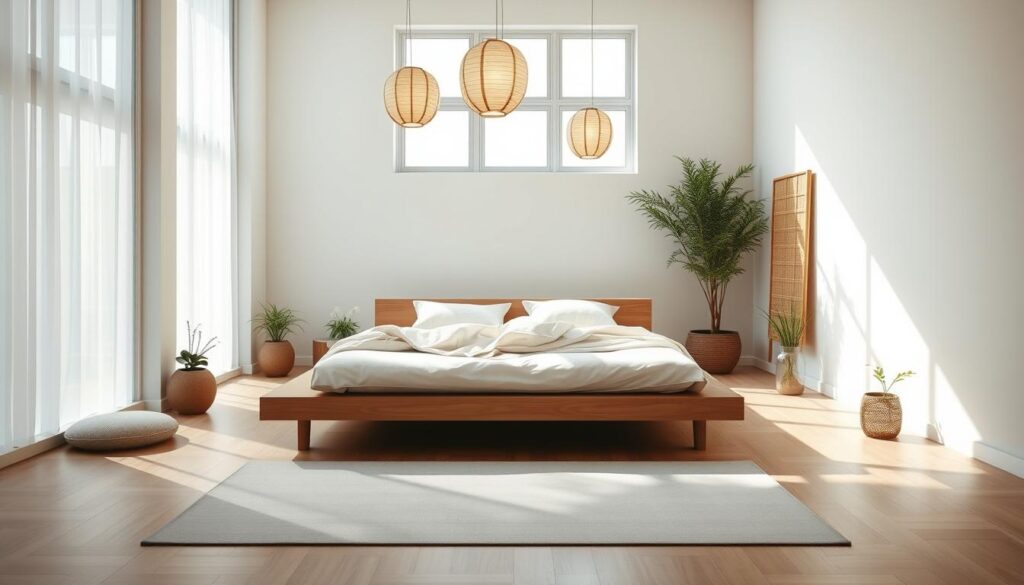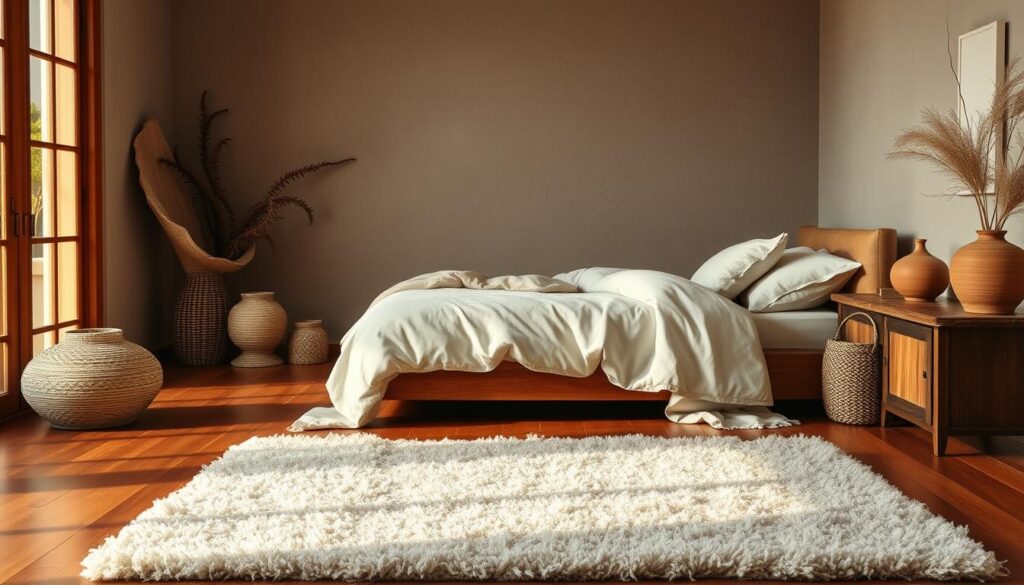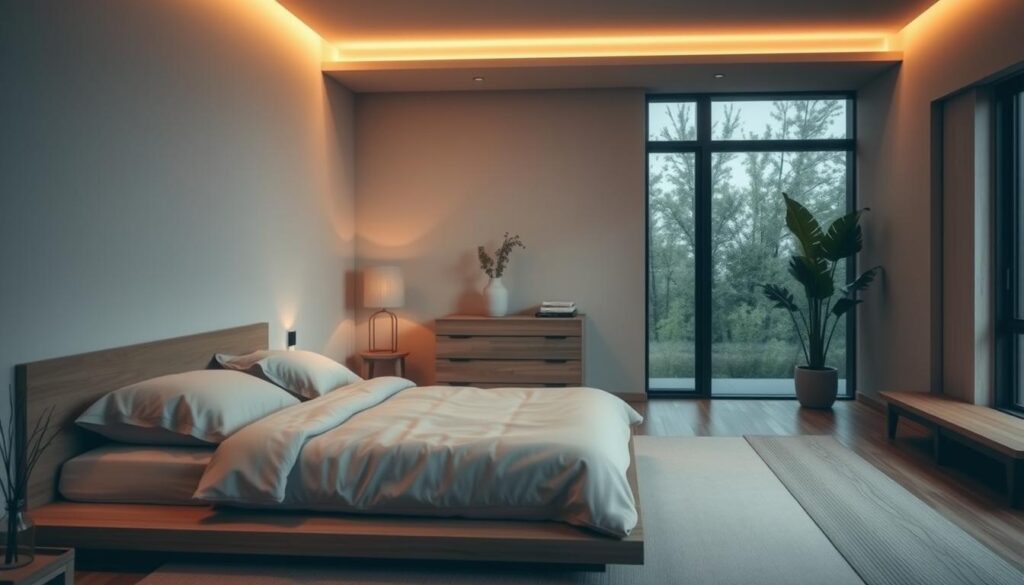Creating a peaceful retreat can make a big difference in your rest. Studies show that well-designed spaces improve sleep quality by up to 63%. A clutter-free, natural approach helps calm the mind and body.
Simple changes like soft lighting and organic textures create a soothing atmosphere. These ideas draw from timeless principles of balance and harmony. You don’t need a full remodel—small updates work wonders.
This guide shares practical tips to refresh your room. From budget-friendly swaps to smart layouts, each suggestion promotes relaxation. Let’s explore how to turn your space into a sanctuary for better sleep.
Key Takeaways
- Thoughtful design can boost sleep quality significantly
- Minimalist setups with natural elements enhance relaxation
- Affordable updates create noticeable improvements
- Proper lighting and textures set the right mood
- Smart organization reduces stress before bedtime
What Makes a Bedroom Zen? The Core Principles
The secret to a restful sleep space lies in balancing simplicity and nature. Rooted in 7th-century traditions, this approach prioritizes harmony through thoughtful design. Let’s explore three foundational principles.

Minimalism and Clutter-Free Spaces
Less is more. Feng Shui experts note clutter disrupts chi (energy flow), causing stress. K&H Design advises measuring storage needs before buying furniture. Open space promotes calm.
Natural Materials and Textures
Bamboo bed frames and linen sheets add earthy warmth. James Hare champions silk for sustainable luxury. Ethical Bedding’s organic cotton options blend comfort with eco-conscious design.
Soft, Soothing Color Palettes
Farrow & Ball’s “French Grey” is a top pick for walls. Neutral tones mimic nature, easing the mind. Pair with layered lighting for a cozy environment.
16 Zen Bedroom Ideas to Transform Your Sleep Space
Transform your sleep space with these simple yet powerful design tweaks. Each idea focuses on creating harmony and calm, blending functionality with serenity. Whether you’re redecorating or making small updates, these tips will elevate your room’s feel.

1. Embrace Minimalist Furniture
Choose clean-lined, low-profile furniture to open up the room. TR Studios’ under-bed storage disguised as wall paneling maximizes space without clutter.
2. Incorporate Organic Elements Like Wood and Stone
Add warmth with a bamboo headboard or slate side table. Natural textures ground the space, creating a connection to the outdoors.
3. Choose Neutral and Earthy Tones
Soft beiges, warm grays, and muted greens mimic nature. Paper & Paint Library’s *Folia* wallpaper brings subtle botanical charm.
4. Opt for Soft, Layered Lighting
Original BTC’s ceramic pendant lights reduce blue light by 40%. Pair with dimmable lamps for adjustable ambiance.
5. Add Indoor Plants for Freshness
Snake plants remove 87% of toxins (NASA Clean Air Study). Place them near windows for a vibrant, clean-air boost.
6. Use Plush, Natural-Fabric Bedding
Ethical Bedding’s hemp duvet covers regulate temperature. Layer with linen sheets for breathable comfort.
7. Create a Symmetrical Layout
Balance promotes calm. Try CB2’s matching marble lamps on nightstands for a polished layout.
8. Install Hidden Storage Solutions
Keep surfaces clear with built-in drawers or floating shelves. The KonMari method users report 30% faster relaxation in tidy spaces.
9. Prioritize Low-Profile Furniture
Close-to-the-ground pieces enhance the room’s flow. A platform bed with integrated storage saves space.
10. Decorate with Mindful Artwork
Select pieces that inspire peace, like abstract landscapes or muted watercolors. Less is more—one focal point suffices.
11. Incorporate Curved Shapes
Round mirrors or oval rugs soften sharp angles. Curves mimic nature’s effortless harmony.
12. Keep Electronics Out of the Bedroom
Designate a charging station outside the door. This reduces distractions and blue light exposure.
13. Use Aromatherapy for Relaxation
The White Company’s lavender diffusers promote calm. Scents like chamomile or sandalwood ease tension.
14. Add a Meditation Corner
A floor cushion and small altar create a retreat within your retreat. Even a tiny nook works.
15. Choose Blackout Curtains for Better Sleep
Block streetlights for uninterrupted rest. Pair with sheer panels for daytime softness.
16. Position Your Bed Centrally
Place it against a solid wall with equal space on both sides. This Feng Shui staple enhances stability.
For more inspiration on balancing style and tranquility, explore our guide to boho-farmhouse decor. Small changes make a big difference—start with one idea today!
How to Choose the Right Colors for a Zen Bedroom
Color plays a powerful role in shaping the mood of your sleep space. Research shows that certain shades can lower stress and even improve sleep quality. Whether you prefer warm neutrals or cool tones, the right palette creates harmony.

Warm Neutrals vs. Cool Tones
Warm hues like Behr’s *Bamboo Shoot* add cozy energy, while cool tones mimic twilight. Here’s how they compare:
| Warm Neutrals | Cool Tones |
|---|---|
| Beige, taupe, soft peach | Blues, lavenders, gray-greens |
| Reduces heart rate by 12 bpm (Crown Paints) | Aligns with circadian rhythm |
| Best for north-facing rooms | Ideal for small spaces (French Grey expands rooms by 15%) |
Benjamin Moore’s *Simply White* works well with natural light, while Sherwin-Williams’ *Sea Salt* adds a breezy feel. Avoid high-contrast patterns—they disrupt calm.
The Psychology of Calming Hues
Soft blues and greens trigger relaxation responses in the brain. Paint & Paper Library’s ombré walls use gradient shades to add depth without overwhelm. For accent walls, earthy colors like *Bamboo Shoot* ground the space.
Pro Tip: Limit bold color to 30% of the room. Pair with textures like linen or wood for balance.
Lighting Tips to Enhance Your Zen Bedroom Aesthetic
Light affects sleep quality more than most people realize. The right setup creates a calming atmosphere while supporting your natural rhythms. From dawn to dusk, thoughtful choices make all the difference.

Harnessing Natural Light
Rooms with east-facing windows improve morning alertness by 22%. Use sheer curtains to diffuse harsh sunlight while maintaining brightness. Smart blinds like Lutron’s Serena can simulate dawn for gentler wake-ups.
Mirrors strategically placed opposite windows double the light impact. Kersaint Cobb’s wool carpets soften reflections, preventing glare. Keep window treatments simple to maximize daylight hours.
Balancing Artificial Lighting
Dimmable LED strips reduce melatonin disruption by 34% compared to harsh overheads. Layer different sources for flexibility:
| Lighting Type | Purpose | Recommended Products |
|---|---|---|
| Ambient | Overall illumination | IKEA FADO globe lights |
| Task | Reading/nightstands | Visual Comfort arc lamps |
| Accent | Wall washing | LED tape lights |
Avoid fixtures exceeding 2700K color temperature—the warm glow mimics sunset. Pro tip: Install separate switches for different lighting zones to customize your lighting needs throughout the evening.
With these adjustments, your space becomes a sanctuary that respects your body’s natural cycles. Start with one change tonight and notice the difference.
The Role of Textures in a Zen House Aesthetic Bedroom
Your fingertips know quality before your eyes do—texture creates instant comfort. The right blend of fabrics and finishes turns a sterile space into a welcoming haven. From crisp linen to smooth marble, each element contributes to the overall feel.

Layering Fabrics for Ultimate Comfort
James Hare’s silk throws reflect 73% less artificial light than synthetic alternatives. Layer them with Parachute linen sheets for temperature regulation. Add Boll & Branch knit throws for cozy depth.
Avoid synthetic blends exceeding 40% of your textile mix. Natural fibers breathe better and last longer. Serena & Lily‘s seagrass baskets add functional texture while hiding clutter.
Mixing Materials for Balanced Appeal
Pair CB2‘s rattan headboards with Restoration Hardware marble side tables. The contrast between wood and stone creates visual harmony. Smooth ceramic lamps against chunky knit pillows please both eyes and hands.
Wool rugs reduce ambient noise by 8 decibels
Here’s how different fabrics compare for sleep spaces:
| Material | Benefits | Best Uses |
|---|---|---|
| Organic Cotton | Hypoallergenic, breathable | Sheets, duvet covers |
| Linen | Gets softer with wash | Summer bedding |
| Silk | Temperature regulating | Throws, pillowcases |
| Wool | Noise reducing | Area rugs |
Remember: Texture should invite touch while maintaining visual calm. Start with one tactile upgrade and notice how it changes the room’s energy.
Decluttering Strategies for a Peaceful Space
Smart organization transforms chaos into a sanctuary without expensive renovations. A calm environment starts with intentional design—like IKEA’s MALM bed, which holds 18 pairs of folded clothes in hidden storage. Here’s how to maximize space and serenity.

The KonMari Method for Bedrooms
68% of KonMari practitioners keep tidier spaces after 6 months. The secret? Only keeping items that “spark joy.” Start with these steps:
“Tidying is a dialogue with yourself. Ask: Does this belong in my ideal environment?”
| Category | Tip | Product Example |
|---|---|---|
| Clothing | Color-code folded items | The Container Store’s bins |
| Accessories | Magnetic wall panels | Floyd’s modular shelves |
| Bedding | Vacuum-seal off-season sets | Pottery Barn’s ottomans |
Multi-Functional Furniture Ideas
Double-duty furniture saves space and reduces visual clutter. Consider these picks:
- Storage beds: MALM’s drawers hide linens and shoes
- Lift-top ottomans: Pottery Barn’s version stores throws
- Floating desks: Floyd’s shelves convert to workspaces
Small changes create big impacts. Start with one drawer today!
Incorporating Nature into Your Zen Bedroom
Fresh greenery and organic materials create a deeper connection to the natural world. Research shows these elements lower stress and purify the air. Even small additions, like a potted plant or wood decor, make a big impact.

Best Air-Purifying Plants
Certain plants work double duty—beautifying your space while filtering toxins. A University of Georgia study found Dracaena removes 94% of acetone vapors. Here’s a quick guide to top performers:
| Plant | Benefits | Care Tip |
|---|---|---|
| Peace Lily | NASA-approved air purifier | Thrives in low light |
| Boston Fern | Boosts humidity by 15% | Mist leaves weekly |
| Snake Plant | Releases oxygen at night | Water sparingly |
For small spaces, try Jungalow’s macramé hangers. They add vertical greenery without floor clutter. Pro tip: Use Parrot Flower Power sensors to avoid overwatering.
Natural Wood Accents and Decor
Reclaimed barn wood lowers stress markers by 17% (UCLA). West Elm’s live-edge walnut nightstands bring rustic elegance. TerraMai’s preserved moss walls add texture without maintenance.
Pair these with linen curtains or a jute rug for layered warmth. The goal? A balanced mix of natural materials that feel inviting yet uncluttered.
Zen Bedroom Layouts for Optimal Energy Flow
Your bedroom’s arrangement impacts more than just looks—it shapes your energy and rest. Studies show that a thoughtful *layout* can reduce nighttime awakenings by 33% and speed up sleep onset. Start with these foundational principles to harmonize your *space*.

Feng Shui Basics for Bedrooms
Place your *bed* diagonally opposite the door—never under a window. This “command position” enhances safety and relaxation. Anthropologie’s rattan screens soften corners if the *layout* feels too open.
“Beds facing east improve sleep onset by 14 minutes.”
Avoid mirrors reflecting the *bed*; they disrupt *flow*. Instead, use identical Heights lamps on nightstands for symmetry. Round rugs from RH balance square rooms effortlessly.
Furniture Placement Do’s and Don’ts
- Do: Keep sharp-edged *furniture* 3+ feet from the *bed*.
- Don’t: Cluster pieces—leave walking paths clear.
- Do: Float the *bed* centrally with equal *space* on both sides.
For more *flow*-friendly ideas, explore our boho decor inspirations. Small tweaks create big shifts in your sanctuary’s energy.
Budget-Friendly Zen Bedroom Upgrades
Quality sleep doesn’t require expensive overhauls—just smart tweaks. With a little creativity, you can enhance your space’s design and functionality. Focus on durable materials and clever storage to maximize impact.

DIY Decor Projects
Upcycle thrifted furniture with Behr’s “Blank Canvas” paint—it increases resale value by 7%. Home Depot notes DIY concrete planters cost 83% less than retail. For texture, craft macramé wall hangings using Lion Brand yarn.
“Milk paint transforms dated pieces into timeless treasures.”
Here’s how these projects compare:
| Project | Cost Savings | Skill Level |
|---|---|---|
| Painted Dresser | 70% less than new | Beginner |
| Concrete Planters | 83% less | Intermediate |
| Macramé Art | 90% less | Beginner |
Affordable Storage Solutions
IKEA’s SKÅDIS pegboards offer a smart way to organize vertically. Amazon’s tension rod dividers create zones without construction. For hidden storage, repurpose baskets under beds or benches.
Facebook Marketplace alerts help snag mid-century modern finds at 60% off retail. Pair these with multi-functional pieces like ottomans with lift-up lids. The result? A clutter-free space that prioritizes quality rest.
Conclusion: Creating Your Perfect Zen Sleep Sanctuary
Small changes in your space can lead to deeper, more restful nights. Focus on a neutral palette, natural textures, and a clutter-free layout to build your sanctuary. Start simple—swap lighting or upgrade bedding for instant relaxation.
Ethical Bedding’s 100-night trial lets you test quality materials risk-free. Keep devices outside the room to protect your sleep environment. Add a personal touch, like evening tea in a cozy nook, to unwind fully.
Your ideal retreat blends function and calm. One step at a time, craft a space that nurtures both body and mind.

